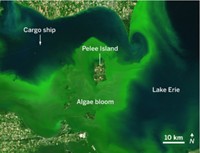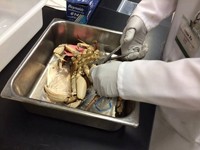Advertisement
Grab your lab coat. Let's get started
Welcome!
Welcome!
Create an account below to get 6 C&EN articles per month, receive newsletters and more - all free.
It seems this is your first time logging in online. Please enter the following information to continue.
As an ACS member you automatically get access to this site. All we need is few more details to create your reading experience.
Not you? Sign in with a different account.
Not you? Sign in with a different account.
ERROR 1
ERROR 1
ERROR 2
ERROR 2
ERROR 2
ERROR 2
ERROR 2
Password and Confirm password must match.
If you have an ACS member number, please enter it here so we can link this account to your membership. (optional)
ERROR 2
ACS values your privacy. By submitting your information, you are gaining access to C&EN and subscribing to our weekly newsletter. We use the information you provide to make your reading experience better, and we will never sell your data to third party members.
Biological Chemistry
Neurotoxin Scuttles Crab Season
Environment: Domoic acid contamination due to algal bloom caused by El Nino-warmed waters in Pacific
by Elizabeth K. Wilson
November 12, 2015
| A version of this story appeared in
Volume 93, Issue 45

Officials have postponed the West Coast’s Dungeness crab season indefinitely because of a massive contamination of the toxin domoic acid. The drastic event not only will disappoint fans of the delicacy but also could cost the commercial crab fishing industry $60 million.
The potent neurotoxin, discovered only in recent decades, is produced by the marine alga Pseudo-nitzschia, which is eaten by shellfish and some small fish. Domoic acid becomes more concentrated, and more dangerous, in organisms further up the food chain, as larger animals eat the contaminated smaller creatures.
Although the algae bloom seasonally, this year’s El Niño-induced warm ocean temperatures off the West Coast have nurtured a massive bloom.
California monitors toxins in seafood year-round and recently detected high levels of domoic acid in Dungeness and rock crabs.
On Nov. 6, the California Department of Fish & Wildlife called off the crab season which was slated to start Nov. 15, from the Oregon border to Santa Barbara.
“Crab is an important part of California’s culture and economy, and I did not make this decision lightly,” Charlton Bonham, CDFW’s director, said in a Nov. 6 statement. “But doing everything we can to limit the risk to public health has to take precedence.”
In small quantities, domoic acid may cause nausea, vomiting, diarrhea, and dizziness. But in higher concentrations, domoic acid can have devastating effects, including seizures, permanent short-term memory loss, coma, and even death. It is odorless and colorless, and it can’t be inactivated by cooking or freezing.
Domoic acid wreaks havoc on an animal’s nervous system by mimicking glutamate and activating a subset of glutamate receptors, explains Justin Brower, a forensic toxicologist with North Carolina’s Office of the Chief Medical Examiner who also pens the blog Nature’s Poisons.
Cells in the brain and nervous system are loaded with glutamate receptors. By binding these receptors, the toxin overexcites the cells, creating a massive influx of calcium into the cells, which kills them.
Still unexplained is why the algae produce the poison, Brower says. It’s not clear what the algae are defending themselves against when they synthesize domoic acid. Some researchers have suggested that domoic acid binds iron and copper, scavenging the metals as nutrients for the algae.






Join the conversation
Contact the reporter
Submit a Letter to the Editor for publication
Engage with us on Twitter